As the first being of Creation and instrumental in causing Ragnarok the Jötnar plays a crucial part in Norse mythology. Sworn enemies of the Aesir and Vanir, the giant jötnar has a complex relationship with the gods. Often at odds, they do battle, but sometimes love affairs form and several of the gods are indeed half jötunn. Without them, there would be no Norse gods.
Three roots stretch three ways
under the ash Ygg’s-steed.
Hel dwells under one,
the Frost Giants under the second,
mortal men under the third.
1883 Gudbrand Vigfusson
in Corpus Poeticum Boreale
“The Sayings of the Hooded One” Verse 24-29
Legends of giant-folk, or the jötnar, as the Vikings knew them, abound in world mythology. Few people though are so involved with them as the mighty Norse raiders of old.
While the Vikings worshipped the Aesir, their tales go into great detail when treating the giant-folk. We learn of ‘Cruel Striker’, ‘Mountain Yeller’, ‘Lazy Walker’, and many more. The names tell of a people familiar to the Norse in great personal detail and not of a distant, unknown enemy.
The jötnar lived in the realm of Jotunheim are not secondary characters, but great warriors, matriarchs, and chieftains in their own right. They intermarry with the gods, do battle, and wager with them. The destinies of jötnar and god are bound up together from the earliest creation myths to the end times of Ragnarok.
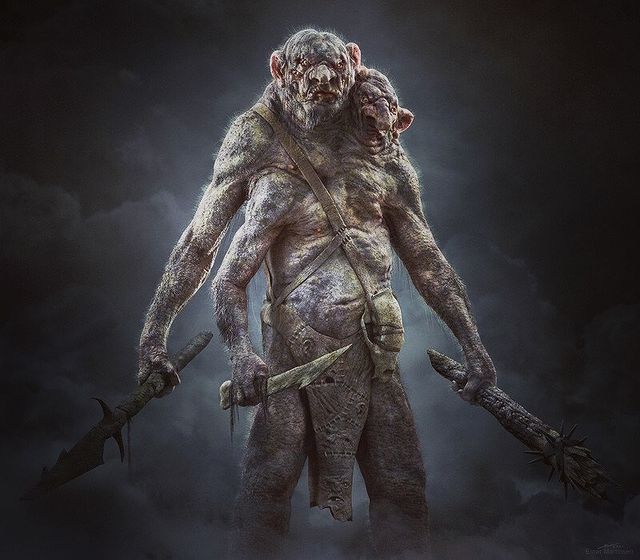
When we trace their history, we find that many of the gods are half-giant by descent. Without the jötnar, there might be no gods at all, or at least, not as we know them today.
It is fitting, therefore, that we should dedicate some time to the most famous of their kind. In this list, you will find those whose acts caused the most harm and also most benefit to the Aesir and Vanir tribes.
Ymir/Aurgelmir, “Screamer”
Ymir is the primordial jötun from whom all other jötnar descend. At the beginning of time, it is he who emerges from the ice as the flames of Muspelheim approach the cold of Nifelheim.
The sweat of his armpit continually gives rise to more giants. When his armpit is dry, they spring forth from his vast thighs. He is both mother and father to the jötunn race.
There also was a primordial god within the ice, Buri, and their kinds soon mixed. Even great Odin is descended from a union between a giantess and a god, making the Allfather at least half jötunn.
When Odin and his brothers set out to eliminate giant-kind from existence, they set first upon Ymir. They slay him as he sleeps and dismembers his body to use as building blocks for the Nine Realms.
Here in Midgard, we walk upon his flesh and bones. When we look up it is the dome of his great skull we see above us. The trees are his hair, his brains, the clouds.
Although the progenitor of all giants and their reputed evil, we owe the very ground we walk on to his existence.
Surt/Surtr, ‘Black’.
Surt (Old Norse Surtr or Surtur), the fire giant, is one of the most fearsome and powerful of all the jötnar. He is a fire giant who inhabits the burning realm of Muspelheim in contrast to the more well-known frost giants.
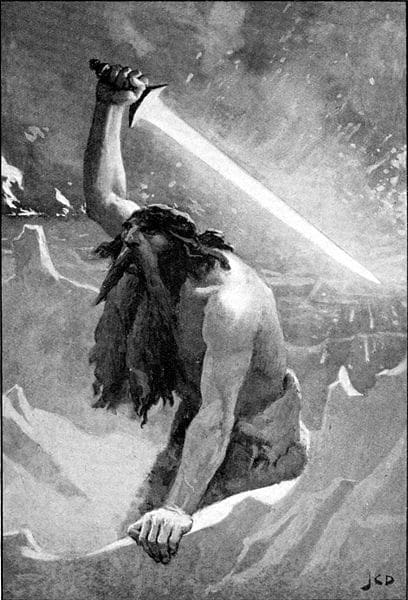
This world-destroying being appears at the time of Ragnarok wielding a giant flaming sword. Before these events, however, we hear little of Surt. We must imagine that he bides his time, storing up hatred for gods and mortals, waiting for the signs that will usher in the end times of the gods.
Once unleashed upon the realms he will use his vast flaming sword to raze mountains, burn cities and obliterate populations. It is Freyr, Vanir god of fertility, hunting, and harvest who will rise to the task of halting his progress.
The two engage in an epic battle that saves Midgard but has tragic consequences nonetheless.
Skadi/Skathi
Skadi the frost giant marries Njord, Vanir god of the sea, due to a unfortunate misunderstanding. She is an austere personage who inhabits the highest regions of the mountains of Niflheim where ice and snow never melt.
Thinking that she is to marry Baldur, the most beautiful god of all, she is disappointed to find it is Njord who she has wed. The two attempt to live together but it is not their destiny to find happiness in each other’s arms.
Gerd/Gerdr, ‘Fenced-in’.
Freyr, like his farther Njord, falls prey to the charms of a giantess. The beautiful Gerd comes to his attention one day as he sits upon Odin’s throne, Hlidskjalf. Seeing all the way to Jotunheim he notices Gerd and instantly becomes love-obsessed by her beauty.
The god of the hunt begins brooding endlessly over his impossible love, to the concern of those around him. Finally his father Njord intervenes. Learning the truth he arranges for the betrothal of the ‘young’ lovers.
As they are so divided by both culture and distance, the agreement is not won without some godly threats. Yet the marriage is finally settled upon and once more we see how love may conquer great differences between two tribes.
Aegir/Hlér/Gymir, ‘Sea’.
Aegir is another giant who fraternizes with the gods. He marries Rán, the fearsome sea goddess who casts her net for sailors upon the seas, drawing them to their death.
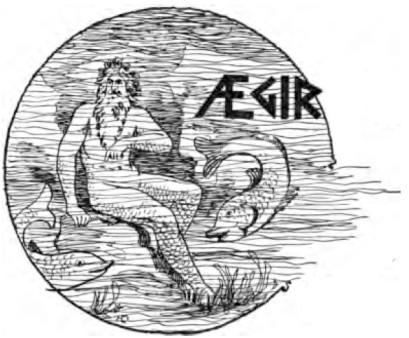
Despite his wife’s morbid pastime, Aegir is a friend to the gods and often hosts them in his great hall. His gatherings are popular and raucous events in the calenders of the gods, and he is associated with the brewing of ale.
Together, he and his wife Rán have 9 daughters, each one associated with aspects of the sea.
Angrboda, ‘the one who brings grief’.
We hear little of the deeds of Angrboda, but her children encircle the destinies of all living things.
Angrboda is a consort of Loki and together they produce children that strike fear into the hearts of gods and mortals alike. Angrboda and Loki together celebrate the birth of three children, each one more fearsome than the last.
The first is Fenrir the gigantic wolf whose jaws can devour a world. The gods have chained him up until the end times and he is responsible for the loss of Tyr, the god of justice’s hand.
Second is Jormungand, the Midgard Serpent, destined to end the life of Thor.
The third is Hel, goddess of the underworld, where Baldur resides in shadows.
This one giant is the mother of forces that will one day decimate the gods and lay waste to entire worlds.
Play Jötunn Quiz
Do you want to learn more about the magical and powerful Jötunn? Then test your knowledge with this fun quiz game!
Don’t forget to play our other games as well!
Mim/Mimir/Hoddmimir
Mimir, the Aesir god of wisdom, is a central character in the sagas of the gods. Without his ever supping lips at the well of wisdom there is much that may not have occurred in the eventful lives of the gods.
He is an uncle of Odin and so a most ancient being. However, we know that Odin himself is part giant and so what of Mimir?
Bestla is the giantess mother of Odin. A mysterious uncle on this side of Odin’s family gifts the young god with 9 magical songs. These songs are so powerful that Odin uses one of them to revive the head of Mimir after his beheading.
It is possible that this wise uncle, possessed of such deep magic, is one and the same with the Aesir god of wisdom. In any case, despite his wisdom, great Mimir still loses his head during the legendary hostage exchange that ended the war between the gods.
This head now resides at Mimisbrunnr and Odin consults it whenever his own wisdom is lacking.
Hrungnir, ‘Brawler’.
One of the most colorful of all the giants, Hrungnir’s tale resounds among the annals of the gods.
The giant was minding his own business when Odin paid him a visit. We don’t know why, but the Allfather issued a wager that his horse Sleipnir would outrun any beast in Jotunheim. He offered his head in return should his steed fail him. Hrungnir, provoked by the god’s arrogance, immediately accepted the offer.
Sleipnir of course proves faster than Gull-faxi, Hrungnir’s mount, but Odin leads the chase back to Asgard. At first, the gods are in good spirits and invite the defeated giant to sup with them. He accepts the invite, but becomes drunk and begins to threaten the gods. He will kill them all, he says, except for Freya and Sif who he will take back with him to Jotunheim.
Strangely, all the gods of Asgard combined are cowed into submission, by this huge giant. They decide to call on Thor who is away fighting giants in other parts.
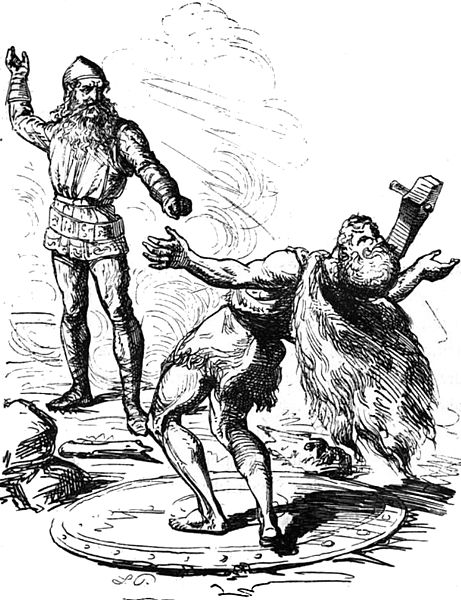
When Thor returns he makes short work of the giant who inspired such fear and splits his head in pieces with trusty Mjolnir.
Bestla, ‘Bark’, ‘Wife’.
Mother of Odin. A wise and ancient being indeed. This great matriarch is a generation beyond the greatest of the Aesir. Time has washed away the meaning of her name, but some interpret it as ‘bark’, others simply as ‘wife’.
For those who tend towards the former, there is a belief that she may be the very bark of Yggdrasil itself. Therefore, great Odin may be the progeny of the World Tree, and as such, is a being unique unto himself.
Bestla is a mother also to Vili and Vé who together with Odin, slay the first giant Ymir and then create Midgard from his slain body.
Bölthorn, ‘Evil-thorn’.
This ancient being is Odin’s grandfather, or by some accounts, his great grandfather.
Should we wonder then, that Odin, protector of mortals, is sometimes capable of gruesome acts of violence? His ancestry leads through Bestla the giant, through her father Bölthorn, and eventually to Ymir himself.
Odin learned 9 magic songs from his grandfather and one of these he used to revive the severed head of Mimir. Without this ancient jötunn magic, the people of Asgard may have been deprived of this wisdom forever.
Although he has an evil name, we know little of his character and without him, there would be no Odin. If he were truly evil he would hardly have passed on his 9 wisdom songs to his grandson.
The 9 Mothers of Heimdallr
These 9 lady giantesses are together responsible for the birth of Heimdallr. They are named as follows: Atla, Angeyja, Eistla, Eyrgjafa, Gjálp, Greip, Imðr, Járnsaxa, and Ulfrún.
The women are sisters and it is possible that they are also the 9 Undines. As such, they may be either giant or half-giant. Aegir we know to be a giant, Ran we are not so sure.
Heimdallr’s father is Odin and magically, the child is borne to all 9 of his consorts. While a collective birth is hard to imagine, the significance of the number nine is central to Norse belief. His association with this magical number makes Heimdallr a unique being among the gods. It is not surprising then, the crucial role he plays throughout his life and then at the end times.
Heimdallr
Is the god Heimdallr a giant? His father is Odin who is himself of giant stock. His 9 mothers are all giants or at least half-lings through their father Aegir.
This question is perhaps best answered by each one who feels drawn to the particular energy of this divine being. He is either way Aesir enough to be counted as one.
Grid, ‘Vehemence’, ‘Violence’, ‘Impetuosity’.
The Allfather was fond of giant women-folk and here is yet another of his jotunn consorts.
Grid is the mother of Vidar who will avenge the death of Odin at Ragnarok by slaying the giant wolf Fenrir. Vidar is also one of the gods who will survive the catastrophe. Together with Vali and Baldur, he will lead the worlds in peace once more.
If her role as mother to Odin’s avenger is not enough, this worthy giantess has also provided aid to the Thunder god. When Thor traveled to do battle with the giant Geirrod, Loki deceived him into entering the giant’s lair without his belt and hammer. When Grid learns of their plans she lends her lover’s son a gauntlet, a belt, and a staff of her own.
In the ensuing battle, it is these power objects that save the Thunder god. Thus did Grid earn her place in the annals of giants allied to the gods.
Thiazi/Thjazi
We remember this infamous giant for his misdeeds in the kidnapping of Idun. He uses his magic to prevent Odin, Hoenir, and Loki from eating an ox they have slaughtered. When the good-natured gods accept that he should have his portion Thiazi gobbles up all the best portions for himself.
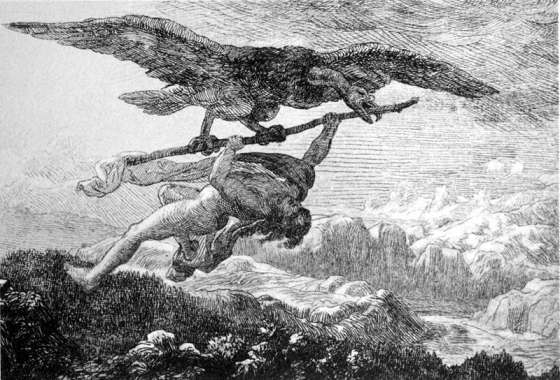
While Odin and Hoenir remain calm, Loki assails the giant with a branch he finds nearby. As ever, the trickster god has bitten off more than he can chew. The giant uses his magic to transform into a huge eagle which then flies away with the terrified Loki.
Lacking both valor and honor, Loki agrees to lure Idun away from Asgard so that Thiazi may imprison her. The miserable pair succeed in their devious plan, although ultimately, it is the giant who has miscalculated the prowess of the gods. It is not long before Idun, life-giver to the gods is rescued and her cruel captor meets the end he deserves.
Jord, ‘Earth’.
This worthy giantess is another of Odin’s jötunn lovers. Although she is not the center of any great story, as the mother of Thor, we cannot exclude her from this list.
Odin sired many children with various consorts, but only one gave rise to the invincible thunder god. We must assume therefore that Jord was no ordinary mother. Her name suggests that perhaps she was more than a mere giant but a force of nature, giving life to the earth itself.
Her other child is Nott, or ‘Night’, the goddess of the nighttime. If we remember Jord only for her children, we must at least acknowledge that they are no ordinary offspring. No doubt wise Odin chose the great giantess for special qualities that he perceived in her and as ever, his wisdom was true.
Hymir/Hymer
This bad-tempered, inhospitable giant features prominently in the tales of the gods. He is the main adversary of Thor in the Lay of Hymir, named after him. What makes his presence more noteworthy is that he is father to Tyr, the Aesir god of law and justice.
The Aesir are looking for a cauldron in which to brew and serve mead for a feast. Tyr informs the gods that his father happens to possess a great vessel that will serve the purpose.
“There dwells eastward of Elivagar the all-wise Hymir, at
heaven’s end. My sire, fierce of mood, a kettle owns, a capacious
cauldron, a rast in depth.”
Verse 5 The Lay of Hymir
Thor and Tyr set out to fetch the item and Tyr’s mother welcomes them into her home. She warns them, however, that Hymir will not be kind to them when he returns.
She lays out a meal for her son and his companion and Thor’s appetite is ravenous. The day after Hymir insists that they must go fishing together if they are to have any food.
Out on the water, Hymir reels in a pair of whales, but Thor outdoes him by hooking the Midgard serpent itself. A mighty contest ensues and Thor is about to smite the monster when Hymir cuts the line, leaving him intact for another day.
On their return, there is much bragging about strength. Hymir insists that Thor must prove his strength by smashing a goblet offered to him by the giant. Thor tries his best but it will not break.
Finally, Tyr’s mother reveals to him that the only thing harder than the goblet is Hymir’s head. Without a second thought, Thor launches the goblet and smashes it to pieces against the giant’s skull.
Although Thor has won the wager, the adventure does not end there. As the gods set out to return home with Hymir’s cauldron a host of giants set upon them. The thunder god decimates their ranks, leaving death and destruction behind him in the land of the giants.
The Mother of Tyr
This friendly giantess has no name in the Lay of Hymir. Her character shines through however and must have been passed on to her son considering his father’s ill-temper.
When her son and Thor arrive at her door looking for Hymir’s great cauldron it is she who invites them in. She warns them that her husband is not likely to be hospitable, even to his own son.
During the bragging contest between Thor and her husband, she reveals the secret of the unbreakable goblet. This allows Thor to break the vessel across her husband’s head.
Despite her marriage bonds, this giantess appears to follow a higher moral code. She places her loyalty to her son and his Aesir friend above that of her husband. Without her intervention, it is unlikely that Thor would have guessed the secret of the goblet and Hymir may have retained his cauldron.
We do not know her name and she is one of those giants who upsets the image of the Jotnar as savage and cruel. As Tyr is also reputed to be a son of Odin, she may be another consort of the Allfather. Either that or she chose to foster Tyr as an infant which is not unknown in Norse giant lore.
Suttung/Suttungr
Suttung is a central figure in the Mead of Poetry tale. This wild giant sought revenge from the evil dwarf brothers Fjalar and Galar for the murder of his father. He tied the pair of deceivers to a rock by the rising tide and waited for them to die.
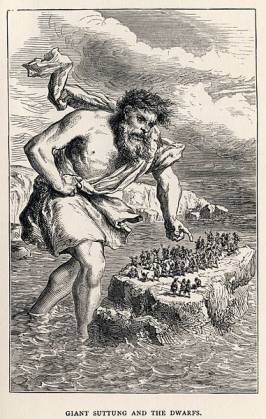
The cunning brothers, however, offered him a magical gift if he would spare their lives. This gift was none other than the mead of poetry which turns all who drink of it into great poets.
Suttung accepted and hid the mead away in the very center of mount Hnitbjorg. He gifted his daughter with powers of witchcraft and set her to guard the priceless drink.
News of the events reached Odin who coveted this mead and so he plotted to obtain it for himself. Unlike his headstrong son Thor, the Allfather decided to gain his prize through subterfuge. Odin knew that Suttung had a brother who was a farmer, and he decided to offer himself, in disguise, as a laborer on his farm.
The Allfather worked for an entire summer until harvest time before asking for a single sip of the mead. Suttung, however, refused this modest request. Odin thus prevailed upon Baugi to drill a hole for him into the mountain chamber where the mead was held.
Once inside the chamber, Suttung’s daughter confronts him. The Allfather however, barters a night of love for three sips of the forbidden liquid.
She accepts the deal and once the night has passed Odin takes three sips which drain all three vessels that hold the mead and makes his escape.
Learning of the theft, Suttung gives chase to the Allfather in the form of an eagle but was unable to retrieve his possession.
In true Allfather style, Odin fathered a son, the god Bragi, with Suttung’s unfaithful daughter.
Baugi, ‘Ring-shaped’.
Baugi is the brother of Suttung and it is to him that Odin comes when seeking the Mead of Poetry.
The Allfather’s plan requires him to work for Baugi, but the farming giant already has nine laborers to do his bidding. Tempting them with a magical whetstone which he casts into the air, the nine workers slay each other in the battle to obtain the stone. Baugi is then happy to accept the work of the diligent stranger.
When Suttung refuses Odin a sip of the mead, Baugi agrees to help him obtain it. In return for his help, the giant will also receive one sip of the mead. When the time comes for Baugi to bore a hole into the mountain chamber where the mead resides he has a change of heart and does not complete the task. The Allfather however, is insistent.
Deeming the hole to be complete Odin enters in. Baugi again changes his mind and attempts to chase after him, but Odin uses his magic to turn into a snake and escapes the giant easily.
Without the conflicted, unwilling help of Baugi, Odin may never have achieved his goal of obtaining the wonderful drink.
Vafthruthnir
Vafthruthnir is a very wise, ancient jötun that Odin visits for a battle of wits in the Vafthruthnirsmál from the Poetic Edda.
Not much is known about him other than what we learn in that exchange between Odin and him. In the end the old jötun loses the wager he himself proposed and with that, in all likelohood he also lost his head. That part is not included in the prose of the poem, but it is inferred from them actually making the wager and neither the vikings or the gods were especially forgiving.
Bergelmir
This giant is very ancient. His father was Thrudgelmir and his grandfather Ymir himself.
When Odin and his kin set out to slay every last giant to rid the worlds of their presence, only Bergelmir and his wife escaped. It is to them alone that the race of frost giants, both good and evil, owe their continued existence in the Nine Realms.
Billingr’s Daughter
Throughout the Norse tales, we learn of Odin’s many conquests among gods, giants, and mortal women. Here, however, we learn of one who was immune to the Allfather’s very considerable charms.
Sadly, we do not know her name, however, she appears in the Hávamál as the daughter of the giant Billing/Billingr. Odin gains her consent to meet after dark in her bedroom. When he tries to gain access, however, an armed guard blocks his way.
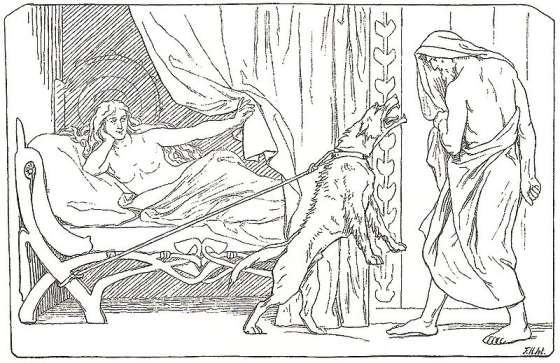
The Allfather decides it will be better to return at daybreak. Finally gaining access to her chambers, he is at first excited, but quickly loses hope. He finds that the comely giantess has chained up a bitch to take her place in the bedroom.
The episode must have deeply affected the Allfather for he recounts the tale himself in lament for the ‘fickleness’ of women. Or at least, this is how he viewed the sequence of events!
Gjalp and Greipa
Gjalp is a giantess who bit off more than she could chew when she tried to obstruct the passage of Thor. The thunder god was traveling to the home of one Geirrod the giant when he had difficulty crossing a river.
Looking upstream he spied a giantess standing astride the river and causing it to fill up, preventing him from crossing. It was none other than Gjalp, one of Geirrod’s daughters.
Justifiably enraged, the thunder good flings a stone at her which finds its mark and he succeeds in the crossing.
When he arrives at the giant’s house, Geirrod shows him to a goat shed where there is one chair to sit on. Thor takes the seat only to find that it is a trap. The chair rises up and crushes him against the roof. Looking down he sees Gjalp and her sister Greipa lifting him up.
The god exercises his great strength and pushes down from the roof until a great crack rings out. It is the sound of the shattering spines of the two giantesses beneath him.
And such was the end of these two evil giant folks who would never crush a visitor to their home again.
The Giant Master Smith
A smith of the giant folk arrived at Asgard and struck a deal with the gods to fortify their home. He guaranteed that he would build a wall in only three seasons, but for this work, he had a high price.
The gods were curious, as the task seemed impossible, so they asked what he would have.
The mysterious smith named the goddess Freya herself as his price for the great task. The gods were reluctant, none more than Freya. Loki however convinced them that it was an impossible wager and that Asgard would have its wall for nothing.
The gods agreed on the deal and the smith set to work. He soon astonished the Aesir with how fast the work progressed with the help of his horse Svadilfari. The horse seemed to be doing more work than the smith!
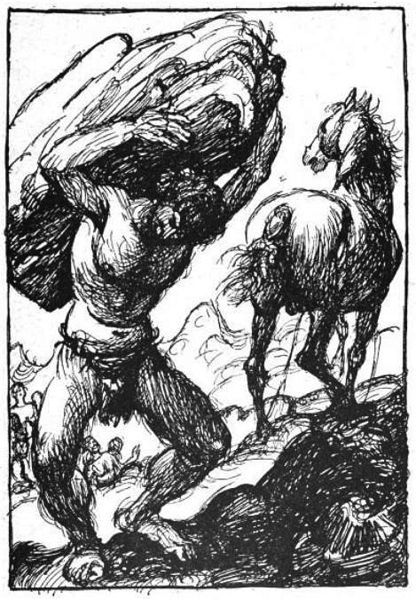
As time passed it became clear that the giant would win his bargain and Asgard would lose beautiful Freya. Seeing the assurances of Loki come to nothing they prevailed violently upon him to ensure this would not come to pass.
Loki knew how severe their punishment would be, so he crafted a plan. On the final evening of the work, he transformed himself into a beautiful mare.
In his comely horse form, he tempted Svadilfari out into the forest. There they chased and cavorted the entire night long.
Without his horse, the giant could not complete his work on time and so he lost the bargain. Loki for his part, lost his virtue to Svadilfari and in due course gave birth. This was none other than Sleipnir, the eight-legged steed of Odin himself.
